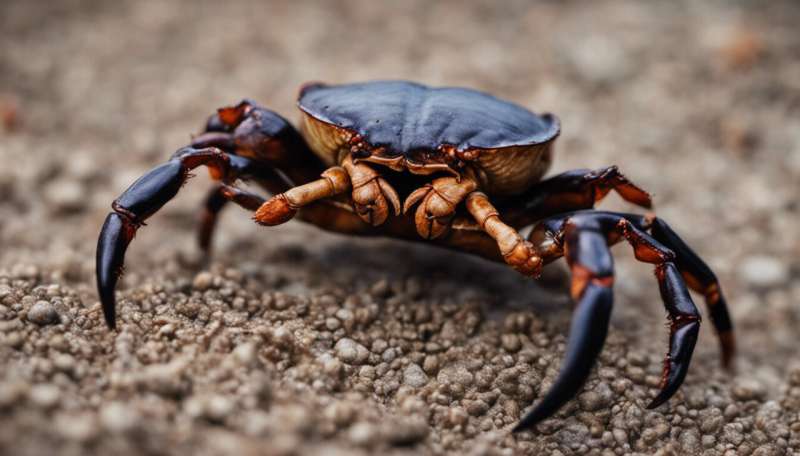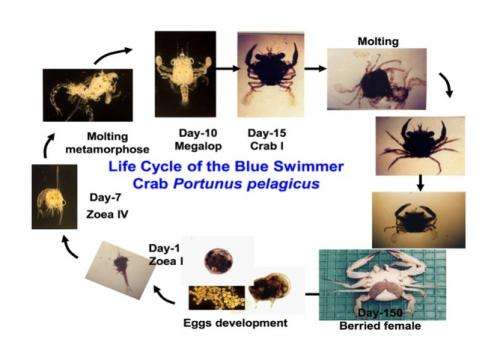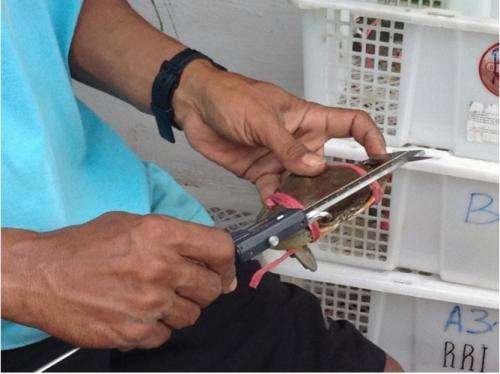How to raise tasty cannibal crabs

Do you like eating crabs? In Jakarta, enjoying the tasty crustaceans has become a hot trend, as more restaurants with names like The Holy Crab and Cut the Crab open up. Crabs are delicious delicacies, great to serve with spicy sauce, either fried or grilled.
While crab meat is not yet a big part of the traditional Indonesian diet, crabs are already big business, here and globally. Crabs are very popular in China and the United States, the two largest consumers of crab in the world.
In recent years, more than half of the crabs exported from Indonesia have been going to the US. In 2011 alone, the nation exported crabs worth US$262 million to the US, more than other large exporters such as China, Vietnam, the Philippines and Thailand.
But humans are not the only ones who like to devour these decapods. Crabs like the taste of their flesh too. They are cannibals.
That unfortunate tendency to eat each other means we have to work even harder to find new ways to breed them.
Crabs will eat their own siblings
It's notoriously difficult to hatch and rear crabs. Once their claws start to develop, they naturally start hunting, even when the only available prey is their own brothers and sisters. Meanwhile, over reliance on wild crabs is diminishing the stock.
The Indonesian government recently released a new regulation limiting the size of crabs that may be caught, as well as banning the trapping of females carrying eggs. But to help address the reduction in the number and size of wild crabs, it would be good if farmers could find more ways to hatch and rear crabs.
At the Research Centre for Oceanography we have been looking for inexpensive ways to effectively cultivate mud crabs and blue swimmer crabs, which could be adopted by local people who already make their livelihood through fish-farming.
The four species of mud crabs – Scylla serrata, S. paramamosain, S. olivacea, S. tranquebarica and the blue swimmer crab, Portunus pelagicus – are all good eating crabs, and all are cannibals.
Because of the difficulty of hatching and rearing crabs, fishers in Indonesia rarely breed them. Instead, they catch them in the wild with bottom gill nets and pots. Any crab farming in Indonesia has generally focused solely on crab fattening: taking crabs from the wild and putting them into traditional brackish water ponds to feed until they are saleable.

Aquaculture has been practised in Indonesia since around CE 1400, when people began trapping milk-fish in coastal ponds. It continues to be widely practised, often using methods that have changed little over the centuries. But crab aquaculture is a much more recent development.
Unlike aquaculture projects overseas that often focus on large-scale capital-intensive and highly automated industries, our focus has, of necessity, been on keeping cost to a minimum.
This is partly because of the limited research-funding available, but also because of a desire to ensure that traditional fishers are not displaced in the interest of efficiency but, rather, are helped to improve their own practises.
New ways to stop crabs eating each other
To prevent crabs eating each other, we've developed ways to house newly hatched crabs individually in cheap plastic cups.
The most common kinds of water cups proved too low, as the crabs could climb out. But it turns out that taller juice cups are just right.
We also tested a variety of feeding regimes to fatten the crabs. We tried various commonly available fish, along with the addition of fish oils and sources of calcium.
The fish diet increased the growth rates of the crabs more than shrimp, their normal diet in the wild. Access to such information will allow farmers to improve the growth rate of their crabs. This will also prevent crabs from being dependent on one kind of diet. Farmers will be able to vary the food they give the crabs depending on the seasonal availability of different fish.
These two simple things – using cheap juice cups to individually house the crabs and feeding them with different formulated diets – allows fishermen to breed crabs from eggs of the female crabs.

Once the crablets are large enough, they can be put into ponds for fattening. Blue swimmer crabs can be cultured with herbivorous fishes in saltwater, and should be harvested within 150 days. Mud crabs require longer to rear, from six to eight months in a brackish water pond.
Raising crabs with milk-fish
Because of the lack of a reliable source of reared crablets, crabs have not been a major part of aquaculture. In Indonesia, many farmers concentrate on fish such as milk-fish Chanos chanos and tilapia Oreochromis spp.
To get fishermen trying out crab aquaculture, we've encouraged them to experiment rearing both milk-fish and crabs in ponds where only milk-fish were reared previously.
The mud crab and milk-fish are housed together in large (10 metre by 10 metre) bottom-net cages, rather than traditional bamboo cages which are less durable.Farmers had immediately pointed out a disadvantage with this arrangement.
The stock had to be fed daily with two different kinds of feed for the crabs and the fish, making it more labor-intensive than monoculture-farming. But the advantages are two crops can be raised and harvested simultaneously and, because they are all placed within the nets, none are lost in the process.
Controlling crab density to avoid cannibalism was a new concept for farmers. For some, it was also novel to find out new technical tricks, such as how to control salinity – a problem that needs to be overcome as the salt content of ponds changes with the seasons and crabs are particularly sensitive to salinity levels.
Developing research projects with farmers enables them to continue to farm in their local ponds, as they have for generations. It also lets them draw on the results of research, enabling them to be more productive and sustainable.
And with this, more people not only in Indonesia but in other parts of the world can enjoy delicious crab meals for decades to come.
Source: The Conversation
This story is published courtesy of The Conversation (under Creative Commons-Attribution/No derivatives).
![]()


















